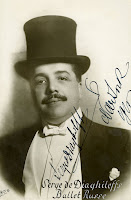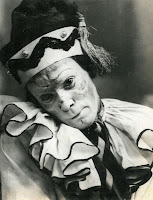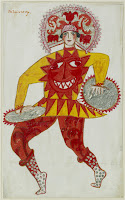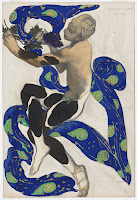A Praiseworthy Tribute to Serge Diaghilev
It is impossible to measure the amount of influence that the legendary Ballets Russes has had on the fine and performing arts since its inception one hundred years ago. It is no wonder then that institutions worldwide are honoring the Ballets Russes with exhibitions and performances on its centennial anniversary. Most recently, two remarkable exhibitions Diaghilev’s Theater of Marvels: The Ballet Russes and Its Aftermath (Donald and Mary Oenslager Gallery, The New York Public Library for the Performing Arts, June 26-September 13, 2009) and The Ballets Russes: Celebrating the Centennial, (Wadsworth Atheneum Museum of Art, Hartford, Connecticut, February 19 – June 21, 2009) paid tribute to the shining achievements of Serge Diaghilev (1872-1929) and his renowned ballet company.
What makes the materials (costumes, diaries, photographs, set designs and sketches of costumes) presented in these two exhibitions so valuable is that Diaghilev forbade his ballets to be captured on film, therefore these are the only remnants that we have available of this spectacles. While the Wadsworth Atheneum has objects that you would expect to see at such an exhibition, the New York Public Library for the Performing Arts displays some real, rare gems that will delight any connoisseur. All in all, the exhibition at the Wadsworth Atheneum can be considered an introduction to the Ballets Russes and the New York Public Library for the Performing Arts exhibition offers a more in-depth look at Diaghilev, the illustrious members of his Ballets Russes troupe, and their influences on other ballet companies during their reign and after the dissolution.
The Wadsworth Atheneum purchased costumes and set designs from Serge Lifar, Diaghilev’s protégé in 1933, (Lifar was in the United States on tour but poor ticket sales resulted in a financial disaster for Lifar, who needed to get his troupe back to France. He decided to sell his art collection for $10,000. to raise money), therefore the museum has amassed an incredible collection of Ballets Russes related memorabilia.
Cocteau’s poster for “Le Spectre de la Rose” (The Spirit of the Rose) of 1911 along with Léon Bakst’s costume design for Vaslav Nijinsky as the Rose in that production, perhaps one the most memorable of the early Ballets Russes costumes, graces the entrance of both of the exhibitions.
The work of Leon Bakst and Alexandre Benois dominate the exhibitions, as both men were responsible for the majority of Ballets Russes costume designs, but other costume designs featured are attributed to Picasso, Gontcharova, Larionov, Roerich, Matisse, and other significant artists like Derain and Roualt.
Both of the exhibitions were splendid but here are some highlights:
Wadsworth Atheneum:
-Amadeo Modigliani’s “Portrait of Léon Bakst” (1917)
-Preliminary Sketch for the Set of Le Tricorne (The Three-Cornered Hat), 1918 by Picasso
-Benois’ Costume Design for Petruschka (1920), of the clown on a stand, must have been a gift to Lifar, who danced the title role.
-Another outstanding work, although created after Diaghilev’s death, is by the Russian artist Pavel Tchelitchew of Lifar as Albrecht in Giselle. (This particular staging of Giselle was in 1932 but while Diaghilev was alive, Giselle was staged in 1910 and, then again, in 1924).
-Costumes, costumes, costumes!
Donald and Mary Oenslager Gallery, The New York Public Library for the Performing Arts:
-Boris Solotareff’s double portrait titled Stravinsky and Bakst (1918) shows two portraits of geniuses on one page.
-Portrait of Leonide Massine (1916), the portrait of Diaghilev’s protégé, by Larionov is very special because Larionov and his wife, the Gontcharova, helped the young dancer with his choreography, which came to reflect the cubofuturist art of his mentors.
-There are several works by Gontcharova but my favorite is the Spanish Woman, a beautiful pochoir from 1920, shows a woman hidden behind a lace veil.
-Benois’ “Tsarskoe selo v tsarstvovanie imperatritsy Elisavety Petrovny,” a rare book, illustrated by members of the World of Art circle, shows the group’s fascination with classical and rococo styles of the eighteenth century later seen in designs for costumes for “Le Pavillon d’Armide” (Armida’s Garden), 1909, the first of the Ballets Russes productions.
-The impresario kept extensive diaries of his ballet company’s performances. His earliest “Black Exercise Book” is from 1909 through 1911. This diary includes casts and programs for projected ballets and operas, lists of dancers, financial records, and budgets, as well as artistic plans for that season.
-The exhibition also spotlights Nijinsky. Two volumes of his diaries, from 1918 and 1919, along with his drawing, “Mask” (1919?), are on view. The ballet dance’s diaries have long been a subject of interest as they were written when he was suffering from a yet undiagnosed case of schizophrenia.
-Fabulous costumes by the Jeoffrey Ballet created for the ballet company which has paid tribute to Diaghilev and the Ballet Russes on several occasions.
-The journal “Illiustrirovannaia Rossiia / La Russie illustrée” (Illustrated Russia, no. 36 [225]) on August 31, 1929 featured a cover photograph of the gondola with Diaghilev’s bier moving through the canals of Venice. The headline reads: “End of a Beautiful Life.”
Calendar
| M | T | W | T | F | S | S |
|---|---|---|---|---|---|---|
| 1 | 2 | 3 | 4 | 5 | 6 | 7 |
| 8 | 9 | 10 | 11 | 12 | 13 | 14 |
| 15 | 16 | 17 | 18 | 19 | 20 | 21 |
| 22 | 23 | 24 | 25 | 26 | 27 | 28 |
| 29 | 30 | 31 | ||||
Archives
- June 2018
- March 2018
- December 2016
- January 2016
- November 2015
- September 2015
- August 2015
- June 2015
- March 2015
- February 2015
- December 2014
- November 2014
- October 2014
- May 2014
- April 2014
- January 2014
- December 2013
- November 2013
- October 2013
- September 2013
- June 2013
- May 2013
- April 2013
- March 2013
- February 2013
- December 2012
- November 2012
- October 2012
- September 2012
- August 2012
- July 2012
- June 2012
- May 2012
- April 2012
- March 2012
- February 2012
- January 2012
- December 2011
- November 2011
- October 2011
- September 2011
- July 2011
- June 2011
- May 2011
- April 2011
- March 2011
- February 2011
- January 2011
- December 2010
- November 2010
- October 2010
- September 2010
- July 2010
- June 2010
- May 2010
- April 2010
- March 2010
- February 2010
- January 2010
- December 2009
- November 2009
- October 2009
- September 2009
- August 2009
- July 2009
- June 2009
Categories
- 20th c. design
- Architecture
- Art Deco
- Art Jewelry Forum
- Art Nouveau
- Auction
- Bard Graduate Center
- Blog update
- Brooklyn Metal Works
- Brooklyn Museum
- Ceramics
- Christie's
- Contemporary Art
- Contemporary Design
- Cooper-Hewitt
- Costume Institute
- Decorative Arts Calendar
- Design Exhibition Review
- Designer Spotlight
- Exhibition review
- Extraordinary lives
- Fashion
- Fashion exhibition review
- Fashion photography
- Film
- Fresh Talent
- Furniture
- Gallery Spotlight
- Glass
- ICP NY
- Italian Design
- Jewelry
- Lecture
- MCNY
- Metropolitan Museum of Art
- MoMA
- Museum at F.I.T
- Museum of Arts and Design
- Neue Galerie NY
- On the Market
- Paper Art
- Paris
- Phillips de Pury & Company
- Pinakothek de Moderne
- Platforma
- Public Art
- Rago
- Recently Published Articles
- Russian Decorative Arts
- R|R Gallery
- Sculpture
- Sotheby's
- Television
- Textiles
- Travel
- Uncategorized
- Upcoming Events
- Vintage Clothing
- Wiener Werkstatte
- Wright




Leave a Reply